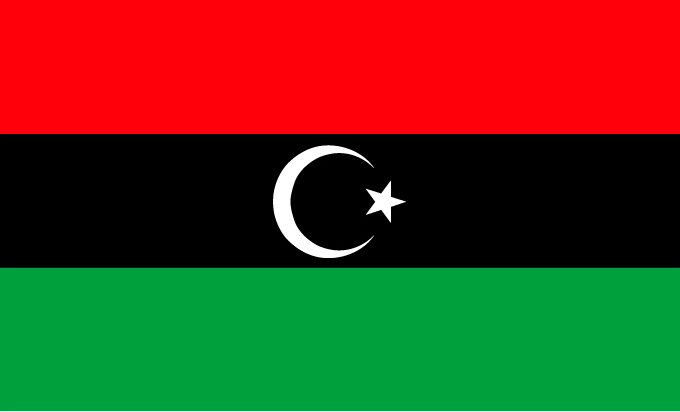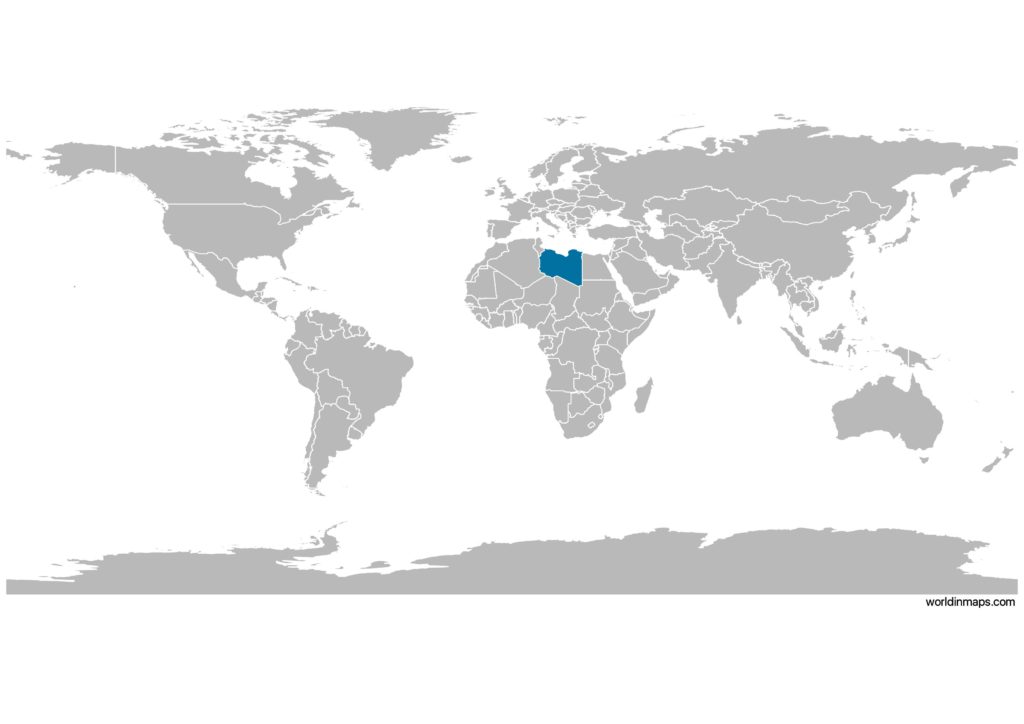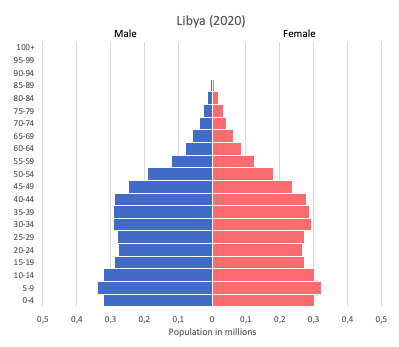Libya

| Government | |
| Name | State of Libya |
| Arabic | دولة ليبيا Dawlat Lībiyā |
| Government type | in transition |
| Capital | Tripoli (1,250,000) |
| Currency | Libyan dinar (LYD) |
| People | |
| Population (2020) | 6,871,287 (108th) |
| Density of population | 3.74 P/km2 (218th) |
| Nationality | Libyan |
| Official languages | |
| Arabic | |
| Ethnic groups | |
| Berber and Arab | 97% |
| other (includes Egyptian, Greek, Indian, Italian, Maltese, Pakistani, Tunisian, and Turkish) | 3% |
| Religions (2010) | |
| Muslim (official; virtually all Sunni) | 96.6% |
| Christian | 2.7% |
| Buddhist | 0.3% |
| Hindu | <0.1% |
| Jewish | <0.1% |
| folk religion | <0.1% |
| unafilliated | 0.2% |
| other | <0.1% |
| Life expectancy (2020) | |
| Male | 74.4 years |
| Female | 79.1 years |
| Total population | 76.7 years (90th) |
| Homicides | |
| n.a. | |
| Geography | |
| Land area | 1,759,540 km2 |
| water area | 0 km2 |
| total area | 1,759,540 km2 (18th) |
| Mean elevation | 423 m |
| Lowest point | |
| Sabkhat Ghuzayyil | -47 m |
| Highest point | |
| Bikku Bitti | 2,267 m |
| Land use (2011) | |
| Agricultural land | 8.8% |
| Arable land | 1% |
| Permanent crops | 0.2% |
| Permanent pasture | 7.6% |
| Forest | 0.1% |
| Other | 91.1% |
| Urbanization | |
| Urban population (2020) | 80.7% |
| Rate of urbanization | 1.68% annual rate of change (2015 – 2020) |
| Economy | |
| Labor force (2017) | 1.114 million (143rd) |
| Labor force by occupation (2004) | |
| Agriculture | 17% |
| Industry | 23% |
| Services | 59% |
| Unemployment rate (2004) | 30% (207th) |
| GDP (PPP) (estimate 2019) | |
| Total | $79.595 billion |
| Per capita | $12,100 |
| GDP (nominal) (estimate 2019) | |
| Total | $51.330 billion (98th) |
| Per capita | $7,803 |
| GDP by sector (estimate 2017) | |
| Agriculture | 1.3% |
| Industry | 52.3% |
| Services | 46.4% |
| Exports (2017) | $18.38 billion (71st) |
| Exports partners (2017) | |
| Italy | 19% |
| Spain | 12.5% |
| France | 11% |
| Egypt | 8.6% |
| Germany | 8.6% |
| China | 8.3% |
| US | 4.9% |
| UK | 4.6% |
| Netherlands | 4.5% |
| Imports (2017) | $11.36 billion (94th) |
| Imports partners (2017) | |
| China | 13.5% |
| Turkey | 11.3% |
| Italy | 6.9% |
| South Korea | 5.9% |
| Spain | 4.8% |
Libya on the world map

Libya top 10 largest cities
- Tripoli (1,250,000)
- Benghazi (700,000)
- Misrata (350,000)
- Bayda (or Elbeida) (250,000)
- Al-Khums (or Khoms) (201,000)
- Zawiya (200,000)
- Ajdabiya (134,000)
- Sabha (or Sebha) (130,000)
- Sirte (128,000)
- Tobruk (120,000)
Demography
Population pyramid

Age structure data
Estimate for 2020:
- 0-14 years: 33.65% (male 1,184,755/female 1,134,084)
- 15-24 years: 15.21% (male 534,245/female 513,728)
- 25-54 years: 41.57% (male 1,491,461/female 1,373,086)
- 55-64 years: 5.52% (male 186,913/female 193,560)
- 65 years and over: 4.04% (male 129,177/female 149,526)
Remark: the age structure of a population affects a nation’s key socioeconomic issues. Countries with young populations (high percentage under age 15) need to invest more in schools, while countries with older populations (high percentage ages 65 and over) need to invest more in the health sector. The age structure can also be used to help predict potential political issues. For example, the rapid growth of a young adult population unable to find employment can lead to unrest.
Population from 1950 to 2020
Source: United Nations, Department of Economic and Social Affairs, Population Division (2019). World Population Prospects 2019, Online Edition. Rev. 1.
Evolution of the life expectancy from 1960 to 2018
Source: World Development Indicators, The World Bank
Economy
Agriculture:
wheat, barley, olives, dates, citrus, vegetables, peanuts, soybeans, cattle
Industries:
petroleum, petrochemicals, aluminum, iron and steel, food processing, textiles, handicrafts, cement
Exports – commodities:
crude oil, refined petroleum products, natural gas, chemicals
Imports – commodities:
machinery, semi-finished goods, food, transport equipment, consumer products
Time zone and current time in Libya
Go to our interactive map to get the current time in Libya